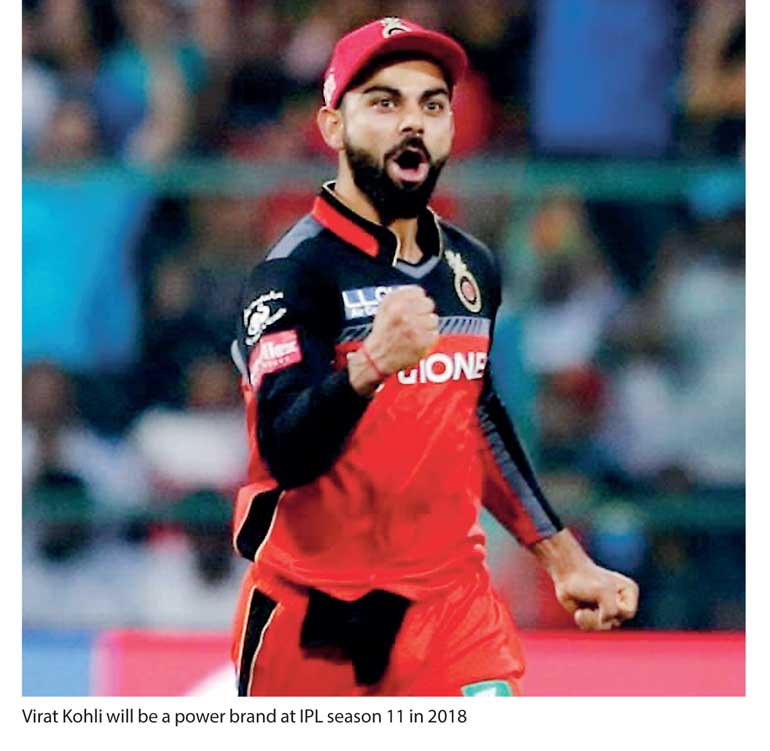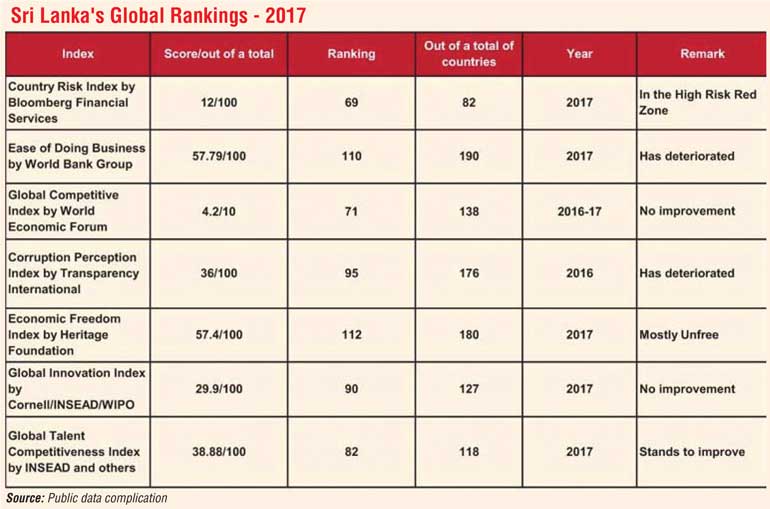Thursday Mar 13, 2025
Thursday Mar 13, 2025
Wednesday, 10 January 2018 00:00 - - {{hitsCtrl.values.hits}}



When an economy is growing at around 4% and the size of the economy is around $ 80 billion, the consumer is challenged when it comes to purchasing power. Inflation in November is at 8.4% as per the National Consumer Price Index whilst the year’s inflation as reported by Central Bank is 4.1%.
What is more worrying for the country is that global ratings of Sri Lanka by top agencies like the World Economic Forum, Transparency International and World Bank, just to name a few, are on the decline. Let me take examples from the sports field and how the lessons can be extended to Sri Lanka’s economy and the link to the rating agencies.
One of the most successful brand building campaigns the world has seen in the recent past is IPL. For instance, the brand was developed in 2008 when the economy was under severe pressure and it was able to attract millions of people to purchase a ticket and experience the brand whilst today the IPL brand is valued at $ 5.3 billion which is a 26% growth over 2016 as per Duff & Phelps, a New York-based corporate finance advisory. The most valuable sub brand is Mumbai Indians with $ 106 million, which indicates the power of brand building and strategy if done properly.
If one does a deep dive on the brand value of the Indian Premier League (IPL) the numbers have increased by 26% in 2017 to reach $ 5.3 billion from $ 4.2 billion in 2016, with new sponsorship deals and planned sales revenue from tournament broadcast plus digital media rights. In my view in the 10 years of IPL in the last 10 years, the world has seen a glimpse of what to expect in the next 25 years. The brand is poised to be $50 billion brand; let me pick up the lessons for Sri Lanka.
The fashion of selling cricket stars for big money was a big ticket item that propelled the IPL brand to be seen differently from other forms of cricket. In other words, IPL developed sub brands out of players that garnered a price. It was an interesting concept but the issue faced in the last 10 years was that some players could not take the pressure and some crashed to unlawful methods of earning money that has led to the brand losing a staggering $ 1 billion during the controversy. But the brand owners did not give up and today the brand has picked up to a commanding $ 5.3 billion dollars which is the power of running a business on a brand model.
The implication to Sri Lanka is the challenged tourism sector. Even though the country crossed 2.1 million visitors into the country we have a situation where the supply of room stock exceeds the demand chain, leading to overall pricing being reduced. Due to inflationary issues the margins being squeezed has led to the overall industry being financially challenged.
With the strong marketing and digital campaign planned for 2017 we can ‘turnaround’ the industry. The question is how many can stretch themselves while waiting for the turnaround. This will also help improve the Country Risk Ratings of Bloomberg where Sri Lanka is at 69 out of 82 countries as at 2017.
Whilst IPL now has a focused set of customers, the challenge is to ride the wave and understand the brand health. There is no point of a brand growing in the short-term with a fashion status consumer following. There has to be re-purchase and a loyalty base developed of core users in strictly marketing terminology. This is what IPL needs to monitor in the next 10 years if one is to do justice to the brand that gave a new imagery to brand India.
Latest research reveals that IPL 10th edition in 2017 generated 1.25 billion impressions on television (awareness of the brand) across the five Sony television channels (an increase of 22.5% over the year before when 1.02 billion impressions were recorded). Incidentally the year before almost 1.25 billion impressions were recorded with nearly 45% of the total viewership coming from rural India, which is further evidence of IPL’s reach but one must monitor the repeat and loyalty levels so that one can determine brand health, especially from the audience that comes for the matches.
For Sri Lanka a key take is Ceylon Tea. Every 15 years we see how the consumer base keeps changing. In 1960 the top five markets were the UK, Australia, USA, Iraq and South Africa. In 1985 the top five were replaced with Egypt, Iraq, Syria, Saudi Arabia and the UK (falling to No. 5 position). If we look at 2016, the top five country mix has changed to Russia, Iran, Iraq, Turkey and the UAE. Hence we see that Ceylon Tea’s brand health is weak and hence we lose the consumer base.
The truth is that economic bloc cartels change tariff rates and hence the demand shifts. But another side of the same is that if the brand building happens, some consumers can be retained. This is one way of Sri Lanka infusing policy changes that will help improve the Global Competitive Index driven by the World Economic Forum, where Sri Lanka is ranked 71 out of 138 as at 2016/17.
Tracking back at IPL for the last 10 years when IPL season 2 ran into tough terrain due to the Indian Government wanting to give priority to election from a security allocation perspective, the then IPL CEO Lalith Modi very clearly made it known to the world that he would cooperate with the Government and not get into a ‘turf war’ even though billions of rupees were at stake.
Lalith Modi in its characteristic style took the high ground and said: “I am going to export this product to another market.” The event that was staged in South Africa was a masterpiece. It was an Indian-African mix that attracted the President of South Africa to be the Chief Guest at the final. The Government of India whilst focusing on the internal objectives supported the IPL CEO’s vision to take the brand global by staging IPL that year in South Africa.
Sri Lanka, take a cue from this and support single-mindedly the Port City. The decision to make this a financial hub was a strong move on this direction. The legislation that is to be passed in February will increase the Ease of Doing Business Index where Sri Lanka is ranked 110 on 190 countries. This indicator is absolutely key if Sri Lanka is to attract Fortune 500 countries to enter its business landscape.
When Lalith Modi decided to commercialise the 20/20 cricket by launching the IPL brand, he believed that nothing was as powerful as an idea that the time had come. He passionately drove the idea when a few actually believed it. As
Trevor Birch, Managing Director, Duff & Phelps and Ex-CEO of Chelsea FC commented ‘ I’ve been intrigued to watch how IPL has marketed and protected its own brand value separate to the clubs.With my experience of having worked with some of the biggest clubs in the English Premier League (EPL).
If Sri Lanka is serious on making exports a 20 billion dollars we must Focus on Ceylon Cinnamon as after all Sri Lanka has a 90% plus market share globally. This sure has the ability to be a power brand given that a new HS code has been mandated with strong policy work by the Government of Sri Lanka that differentiates Ceylon Cinnamon from the cassia that is flooding the global market. We must drive this business for value addition bench marking the apparel industry of Sri Lanka. We have to drive up the Global Innovation Index which is at 90 out of 127 countries. For instance China has developed 71 innovations in the last five years generating $331 billion to the economy in terms of revenue.
It may sound like a hyped-up idea but the reality is that IPL just like any other consumer brand is targeting youngsters who make up a big market in the socio-demographic template. If one were to do a competitor map, they were spending two hours at the gym working out, a group of friends enjoying an evening drink at a club or watching that favourite TV program at home. Hence IPL originators identified that the only way to lure them was to provide a carnival atmosphere with music, dancers and excitement with ruthless competitiveness that eventually garnered 40,000 eyeballs to the brand. According to Varun Gupta, Managing Director, Duff & Phelps India, IPL grabbed eyeballs for all the right reasons.
To me the parallel is Sri Lanka’s wildlife tourism. A recent study has revealed that Sri Lanka boasts the highest propensity to see wildlife animals. What is required is a strong policy to drive this to the key global markets where the eyeball attraction finds this concept interesting. Last week Yala National Park was in the news for having to increase the number of jeeps to 600 per day that will sure affect the wildlife health.
The best example to the world is how Rwanda positioned the mountain gorilla viewing experience. Today, this happens to be the number one foreign exchange earner for the country where entrance fees are $ 1,500 per person and only 150 guests per day whilst the booking has to be done 18 months before. Sri Lanka has to address this issue.
If one tracks back as to why IPL has become a strong brand, one of the key reasons is that its founder Lalith Modi got the best talent to back him. Be it Shah Ruk Khan, Priety Zinta or Dhoni, the best young lifestyle TV presenters. Apparently the franchisees were told to focus on the 10- to 12-year-olds as they would be the target consumers of tomorrow and they also have the power to influence the family.
Sri Lanka needs to do the same by getting the top personalities to talk of brand Sri Lanka which is at $ 78 billion, growing at just 5%. The former Rotary World President K. Ravindran, Nobel Prize winner Prof. Mohan Munasinghe and top sportsman Kumar Sangakkara just to name a few are the brand names that can make Sri Lanka a power brand. But the question is whether they will want to be a brand ambassador when Sri Lanka is ranked 95 out of 176 countries in Transparency International’s Corruption Perception Index.
(The author is a thought leader, public speaker and business personality and can be contacted on [email protected]. The thoughts are strictly his personal views.)
Discover Kapruka, the leading online shopping platform in Sri Lanka, where you can conveniently send Gifts and Flowers to your loved ones for any event including Valentine ’s Day. Explore a wide range of popular Shopping Categories on Kapruka, including Toys, Groceries, Electronics, Birthday Cakes, Fruits, Chocolates, Flower Bouquets, Clothing, Watches, Lingerie, Gift Sets and Jewellery. Also if you’re interested in selling with Kapruka, Partner Central by Kapruka is the best solution to start with. Moreover, through Kapruka Global Shop, you can also enjoy the convenience of purchasing products from renowned platforms like Amazon and eBay and have them delivered to Sri Lanka.
Discover Kapruka, the leading online shopping platform in Sri Lanka, where you can conveniently send Gifts and Flowers to your loved ones for any event including Valentine ’s Day. Explore a wide range of popular Shopping Categories on Kapruka, including Toys, Groceries, Electronics, Birthday Cakes, Fruits, Chocolates, Flower Bouquets, Clothing, Watches, Lingerie, Gift Sets and Jewellery. Also if you’re interested in selling with Kapruka, Partner Central by Kapruka is the best solution to start with. Moreover, through Kapruka Global Shop, you can also enjoy the convenience of purchasing products from renowned platforms like Amazon and eBay and have them delivered to Sri Lanka.